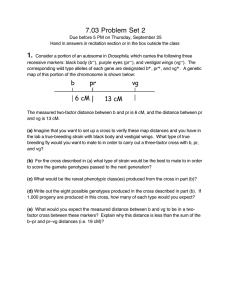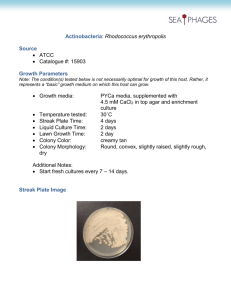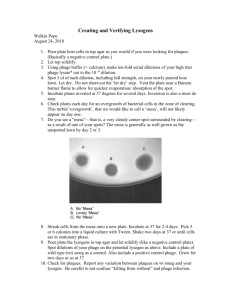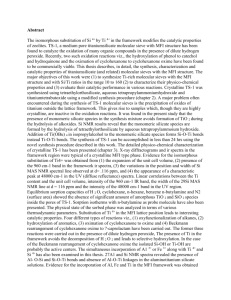Document 13525828
advertisement
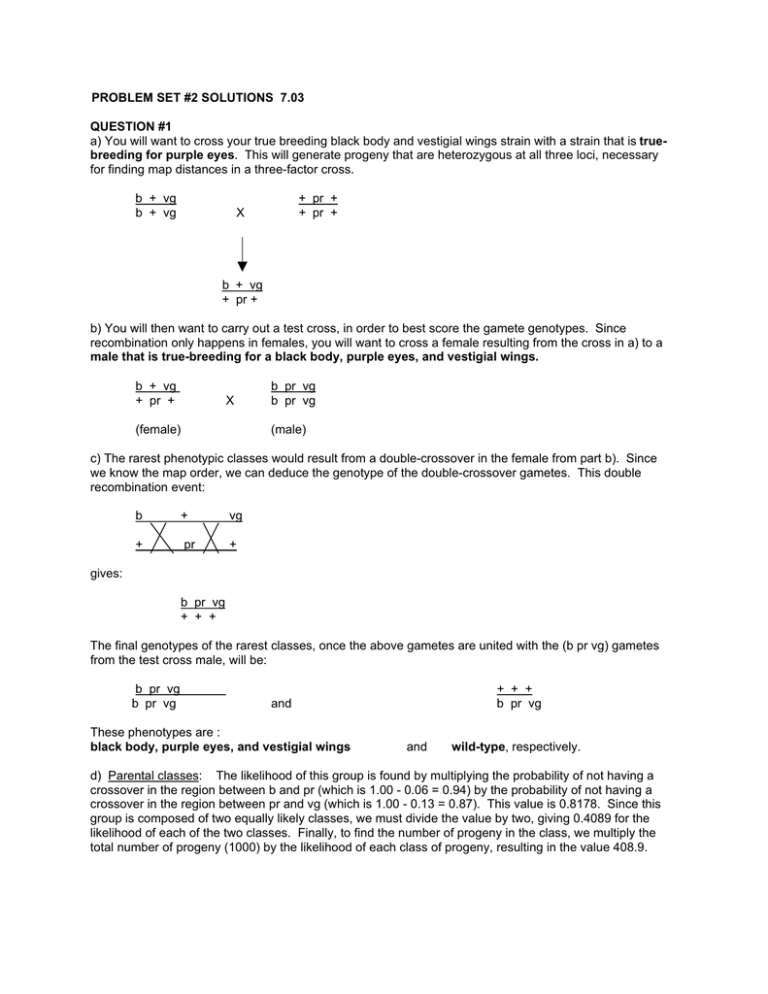
PROBLEM SET #2 SOLUTIONS 7.03 QUESTION #1 a) You will want to cross your true breeding black body and vestigial wings strain with a strain that is truebreeding for purple eyes. This will generate progeny that are heterozygous at all three loci, necessary for finding map distances in a three-factor cross. b + vg b + vg + pr + + pr + X b + vg + pr + b) You will then want to carry out a test cross, in order to best score the gamete genotypes. Since recombination only happens in females, you will want to cross a female resulting from the cross in a) to a male that is true-breeding for a black body, purple eyes, and vestigial wings. b + vg + pr + X (female) b pr vg b pr vg (male) c) The rarest phenotypic classes would result from a double-crossover in the female from part b). Since we know the map order, we can deduce the genotype of the double-crossover gametes. This double recombination event: b + vg + pr + gives: b pr vg + + + The final genotypes of the rarest classes, once the above gametes are united with the (b pr vg) gametes from the test cross male, will be: b pr vg b pr vg + + + b pr vg and These phenotypes are : black body, purple eyes, and vestigial wings and wild-type, respectively. d) Parental classes: The likelihood of this group is found by multiplying the probability of not having a crossover in the region between b and pr (which is 1.00 - 0.06 = 0.94) by the probability of not having a crossover in the region between pr and vg (which is 1.00 - 0.13 = 0.87). This value is 0.8178. Since this group is composed of two equally likely classes, we must divide the value by two, giving 0.4089 for the likelihood of each of the two classes. Finally, to find the number of progeny in the class, we multiply the total number of progeny (1000) by the likelihood of each class of progeny, resulting in the value 408.9. 1) b + vg = black, vestigial. 0.94 * 0.87 *1000 = 408.9 2 = purple. 0.94 * 0.87 *1000 = 408.9 2 b pr vg 2) + pr + b pr vg Classes from recombination between b and pr: The likelihood of this group is found by multiplying the probability of having a crossover between b and pr (which is 0.06) by the probability of not having a crossover in the region between pr and vg (which is 1.00 - 0.13 = 0.87). This value is 0.0522. Since this group is composed of two equally likely classes, we must divide the value by two, giving 0.0261 for the likelihood of each of the two classes. Finally, to find the number of progeny in the class, we multiply the total number of progeny (1000) by the likelihood of each class of progeny, resulting in the value 26.1. 3) b pr + = black, purple 0.06 * 0.87 *1000 = 26.1 2 = vestigial 0.06 * 0.87 *1000 = 26.1 2 b pr vg 4) + + vg b pr vg Classes from recombination between pr and vg: The likelihood of this group is found by multiplying the probability of not having a crossover between b and pr (which is 1.00 - 0.06 = 0.94) by the probability of having a crossover in the region between pr and vg (which is 0.13). This value is 0.1222. Since this group is composed of two equally likely classes, we must divide the value by two, giving 0.0611 for the likelihood of each of the two classes. Finally, to find the number of progeny in the class, we multiply the total number of progeny (1000) by the likelihood of each class of progeny, resulting in the value 61.1. 5) b + + = black. 0.94 * 0.13 *1000 = 61.1 2 = purple, vestigial 0.94 * 0.13 *1000 = 61.1 2 b pr vg 6) + pr vg b pr vg Classes from double recombination events: The likelihood of this group is found by multiplying the probability of having a crossover between b and pr (which is 0.06) by the probability of having a crossover between pr and vg (which is 0.13). This value is 0.0078. Since this group is composed of two equally likely classes, we must divide the value by two, giving 0.0039 for the likelihood of each of the two classes. Finally, to find the number of progeny in the class, we multiply the total number of progeny (1000) by the likelihood of each class of progeny, resulting in the value 3.9. 7) b pr vg = black, purple, vestigial 0.06 * 0.13 * 1000 = 3.9 2 = wild-type 0.06 * 0.13 * 1000 = 3.9 2 b pr vg 8) + + + b pr vg e) The measured distance in a two factor cross would come from the formula: ((recombinant gametes) / (total gametes)) x 100 = distance in cM Looking at the classes above, we will look only at the genotypes and phenotypes for b and vg, since information about the final marker, pr, would not be gathered in a two-factor cross experiment. Each class will be labeled as recombinant or parental, and the values found in part d entered. 1) b vg b vg black, vestigial parental 408.9 2) + + b vg wild-type parental 408.9 3) b + b vg black recombinant 26.1 4) + vg b vg vestigial recombinant 26.1 5) b + b vg black recombinant 61.1 6) + vg b vg vestigial recombinant 61.1 7) b vg b vg black, vestigial parental 3.9 8) + + b vg wild-type parental 3.9 Using the formula given above, the distance in cM is 26.1+ 26.1+ 61.1+ 61.1 *100 = 17.4 cM 1000 This distance is less than the sum of the b-pr and pr-vg distances (i.e. 19 cM) because a two factor cross cannot take account of double crossover events. Particularly, classes 7) and 8) do in fact result from double-crossover events, as we learned in part d), but in a two-factor cross, they appear to simply be parentals, i.e. identical to classes 1) and 2). They are therefore not included in the numerator of our calculation, and the numerator is thus smaller, and the final distance is found to be smaller. In fact, in doing the two-factor cross we would actually see just four classes. One would be the parental class which gave black, vestigial flies (with 408.9 + 3.9 = 412.8 flies), the next would be the parental class which gave wild-type flies (with 408.9 + 3.9 = 412.8 flies), the third class would be the recombinant class which gave vestigial flies (with 61.1 + 26.1 = 87.2 flies), and the final class would be the recombinant class which gave black flies (with 61.1 + 26.1 = 87.2 flies). The recombination frequency would then be 87.2 + 87.2 *100 = 17.4 cM 1000 Question #2 a) Since mating arg1- and arg2- to wt results in a wt phenotype, we know that both arg1- and arg2- are recessive to wt. Mating the two recessive mutants to each other (complementation test) results in a wt phenotype, meaning that the two mutations complement each other, and are therefore in 2 different genes. b) Determination of tetrad type: If no crossovers = Parental If one crossover = Tetratype __arg1-_____+_____ __arg1-_____+_____ Genotype arg1- + arg1- + Phenotype ArgArg- __+_______arg2-___ __+_______arg2-___ + arg2­ + arg2­ ArgArg- __arg1-_____+_____ __arg1-_____+_____ Genotype arg1- + arg1-, arg2- Phenotype ArgArg- __+_______arg2-__ __+_______arg2-__ ++ + arg2- WT Arg- Parental ditype yields 4 Arg- spores in each tetrad, and tetratype yields 3 Arg- spores and 1 Arg+ spore in each tetrad. Therefore type 1 tetrads are Tetratype, and type 2 tetrads are Parental Ditype. Since there are two tetratype tetrads (resulting from a crossover) and 18 parental tetrads (no crossover) we can tell that the two mutations are linked (PD doesn’t equal NPD), but not so closely linked that no recombination occurs (some tetratypes are observed). Also, we can tell that there have been no double crossover events because no NPDs are observed. Since tetratype tetrads are the result of a recombination event , the distance between arg1 and arg2 can be calculated by: # tetratypes 2 *100cM = 100 * = 5cM between arg1 & arg2 2 * (# tetrads) 2 *20 This tells you that the genes are tightly linked. c) Mating arg3- to wt yields an Arg- phenotype, therefore arg3- is dominant to wildtype. Thus, the mating of arg3- with arg1- does not yield any additional information about the relationship between arg1 and arg3 because a complementation test is only useful when both mutations are recessive. d) Determination of tetrad type: (types 1 and 2 as above) If two crossovers = NPD ___arg1_______+___ ___arg1_______+___ ____+________arg3_ ____+________arg3_ The double crossover yields 6 equally likely genotypes: (parentheses surround spore genotypes) 2(arg1-+); 2(+ arg3-) 2(arg1- arg3-); 2(+ +) 1(arg1- +); 1(arg1-, arg3-); 1(+ +); 1(+ arg3-) Parental (one way of getting this) NPD (one way of getting this) Tetratype (4 ways of getting this) Type 3 is consistent with the NPD phenotype, type1 with the Tetratype, and type 2 with PD. One might note that the ratio of PD:T:NPD is approximately 1:4:1, signifying that these two genes are unlinked. To check mathematically whether these genes are linked or not, we employ the equation for linkage when NPDs are observed: 100 * T + 6 * NPD 12 + 6* 3 = 100 * = 75cM 2* tetrads 2* 20 75 cM is still a valid measure of genetic distance, and indicates that the genes are very far apart on the same chromosome. A value this high, however, can basically be considered unlinked. e) From above we have learned that arg1 and arg2 are closely linked, and that arg1 and arg3 are unlinked. It follows that arg3 is not linked to arg2 either,(or we would have observed this linkage in part d due to the proximity of arg1 and arg2). In other words, if two genes are close together, and another gene is known to be far from one of them, it follows that it is far from the other as well. The ratio of P:T:NPD for unlinked genes is approximately 1:4:1, so given that arg2 and arg3 are unlinked, from 60 tetrads we would expect 10 PD:40 T:10 NPD. QUESTION #3 a) The distance between ts-1 and ts-2 in map units is given by the formula: distance (in m.u.) = (recombinant phage) / (total phage) x 100 We are told that there are 10^5 plaques per mL when E. coli is co-infected by ts-1 and ts-2 and then plated at 30 degrees. Since this is the "permissive" temperature, i.e. the temperature where all the phage, including mutant phage, will form plaques, we can take this value as the total concentration of phage. (A tangential word about the phage lifestyle. Each plaque is simply a site where no bacteria are growing. This means that a large number of bacteria were essentially exploded open by occupying phage. While a large number of bacteria must be destroyed in order to form one plaque, each plaque is the result of only one phage and all of it's progeny (that is, a clonal population). Each plaque on a plate will come from a different phage, and therefore we can examine the number of plaques to learn about the types of phage that we have.) We are also told that 300 plaques per mL appear when E. coli is co-infected by ts-1 and ts-2 and then plated at 42 degrees. Since this is the "repressive" temperature, i.e. the temperature where neither of the mutants will form plaques, plaques that form at this temperature must be the result of a recombination event. We can diagram this recombination event: ts-1 + + ts-2 + + ts-1 ts-2 Note that this recombination event led to two types of phage, wild-type phage and double-mutant phage. Only the wild-type phage will give plaques at 42 degrees. The double-mutant phage, however, should also be counted as recombinant phage. Therefore, we multiply by two the number of wild-type phage. Thus, the distance is = (2 x 300 plaques/mL) / (10^5 plaques/mL) x 100 = 0.6 m.u. b) If you cross a ts-1 phage strain to a ts-2, cl- phage strain, they will initially coinfect E. coli cells but eventually, as cell lysis goes on, there will only be one type of phage infecting each bacterial cell. When plated at 30 degrees, both types of phage will form plaques. We will assume that both, those with the cI mutation and those with a wild-type copy of cI, are equally successful at invading bacterial cells. Then, 1/2 of the plaques will have clear centers, this group coming from the half of the phage that carry the cl- mutation, and the other 1/2 will have turbid centers, those coming from the half of the phage that are wild-type in the cl gene. Note that recombination will not change the relative numbers of phage that have the cl- mutation and the wild-type copy of the cl gene. c) In order to have plaques at 42 degrees, the repressive temperature, a recombination event must occur between ts-1 and ts-2. This will result in phage that are doubly mutant for ts-1 and ts-2 (these recombinants will not grow) and phage that are wild-type for ts-1 and ts-2 (these recombinants will grow). Among the phage that do grow, i.e. those that are wild-type for ts-1 and ts-2, we see 85 that form clear plaques and 15 that form turbid plaques. The clear plaques (those with the cI- mutation) are more common; the turbid plaques (those with a wild-type copy of cl) likely resulted from an additional recombination event. There are three potential orders for these genes: cI in the middle, ts-1 in the middle, and ts-2 in the middle. Let's look at each of these orders and what genotype results from a single and double recombination event: The first order that we will consider is having ts-2 in the middle. ts-1 + + ts-1 ts-2 cI­ + ts-2 cI- + + + A single recombination event between ts-1 and ts-2 results in two classes, the one of interest is wild-type in ts-1 and ts-2 and would form turbid plaques. ts-1 + + ts-1 ts-2 + + ts-2 cI- + + cI- A double recombination event gives two types of phage, the one of interest is wild-type in the ts-1 and ts­ 2 genes and forms clear plaques. If this were the gene order, we would expect that at 42 degrees, turbid plaques would be more common than clear plaques. This is not what we observe, so it cannot be the order. The next order to consider is putting ts-1 in the middle: + ts-1 + + + cI- ts-2 + cI- ts-2 ts-1 + A single recombination event between ts-1 and ts-2 results in two classes, the one of interest is a phage that is wild-type in ts-1 and in ts-2 and would form clear plaques. + ts-1 + + + + ts-2 + cI- ts-2 ts-1 cI- A double crossover event gives two types of phage, the one of interest is wild-type in ts-1 and ts-2 and would form turbid plaques. If this were the gene order, we would expect that at 42 degrees, clear plaques would be more common than clear plaques. This is what we observe, so this is a possible gene order. Now we need to figure out the distances between the genes. We have 100 plaques at 42 degrees, each of these resulted from a recombination event between ts-1 and ts-2. 15 of these plaques are turbid, resulting from a second recombination event between ts-1 and cI. In this case, we do not need to double-count the recombinants, since the other resulting recombinant class is not part of the 100 plaques examined. Using the formula: distance from ts-1 to cI (m.u.) = (15/100) x 100 = 15 m.u. A final map is: ts-2 ts-1 cI 0.6m.u. 15 m.u. We have neglected considering the final order, with cI in the middle. This order is also possible, but giving the map above is a complete answer; we are only providing this alternative order for completeness. When cl is in the middle, we have the following arrangement: ts-1 + + + cI- ts-2 A single crossover could occur either between ts-1 and cI or between cI and ts-2. ts-1 + + + cI- ts-2 If a single crossover occurred between cI and ts-2, the result would be: ts-1 + ts-2 + cI- + Among these recombinants, the one that has the wild-type copies of the ts-1 and ts-2 gene would have clear plaques. ts-1 + + + cI- ts-2 If a double crossover occurred, the result would be: ts-1 cI- + + + ts-2 Among these recombinants, the one that has the wild-type copies of the ts-1 and ts-2 gene would have turbid plaques. If this were the gene order, with cI in the middle, and the likelihood of a single crossover more likely between cI and ts-2 (and not ts-1 and cI), then we would see the results described, i.e. more clear plaques than turbid plaques among 100 plaques examined at 42 degrees. The map distance between ts-1 and cI would then be 15% of the map distance between ts-1 and ts-2. Since we already know the map distance of ts-1 and ts-2 to be 0.6 m.u., the final map would be: ts-1 cI0.09 m.u. ts-2 0.51 m.u. The remaining possibility is that the distance between cI and ts-1 is much larger than the distance between cI and ts-2 for this map order. However, this arrangement will give more clear than turbid plaques, and is therefore disproved by our experimental results.
